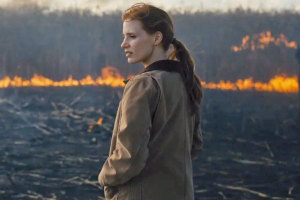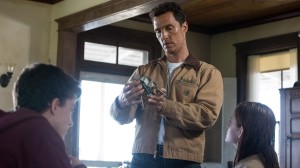At some point early on in Roland Emmerich’s apocalyptic disaster film 2012 (2009) we know that 999.85 per mille of the world’s population is doomed to perish in the coming flood. We also learn that, secretly, the governments of the most powerful nations on Earth, the G8, have built nine gigantic arks, capable of carrying 900,000 persons altogether.
This 0.15 per mille of humanity, a tiny elite representing the very same ruling class that brought environmental disaster upon us in the first place (although the film blames it all on the sun), is now “our” last chance of saving “civilization.” In order for us to involve ourselves emotionally in this project to “save humanity,” and forget about the fact that we, our families, and everyone we know have been told to fuck off, Emmerich et al. throws in a few “ordinary” people; mainly the chauffeur Jackson Curtis (John Cusack) and his family, that may or may not have a chance to make it on board one of the arks. Go Jackson, go!
Call me selfish, but if less than one in ten thousand of the world’s population – selected by the US president, the leadership of the Chinese Communist Party, and their most powerful global colleagues – are to survive, then, as far as I’m concerned I’d rather call it a day.
Much as in 2012, most of humanity has already been doomed at the beginning of Christopher Nolan’s three hour-long apocalyptic science fiction drama Interstellar. Maybe one per cent of Earth’s population is left alive. Nolan doesn’t specify this, but who cares? What matters is that, by the time our heroes start “saving humanity,” most of us are already dead.
 Something – there’s no mention of global warming, but we take for granted that it is the cause – has led to extreme drought, starvation and war. The closest the film comes to giving us an explanation for the event comes in a moralistic monologue delivered by “grandpa” Donald (John Lithgow) about how, in the old days, “everybody wanted everything” (this may not be a verbatim quote, but it’s close enough). Such a statement regarding our pre-apocalyptic present, while tens of thousands of people in the heart of America are being deprived even of such a basic necessity as running water, is nothing less than obscene.
Something – there’s no mention of global warming, but we take for granted that it is the cause – has led to extreme drought, starvation and war. The closest the film comes to giving us an explanation for the event comes in a moralistic monologue delivered by “grandpa” Donald (John Lithgow) about how, in the old days, “everybody wanted everything” (this may not be a verbatim quote, but it’s close enough). Such a statement regarding our pre-apocalyptic present, while tens of thousands of people in the heart of America are being deprived even of such a basic necessity as running water, is nothing less than obscene.
In the film’s present most of the remaining population of the USA are living as farmers (the world outside of the USA is almost completely ignored by the film, something that is actually rather unusual in the genre). On vast fields they each grow their chosen crops, according to the principles of monoculture. But one by one the remaining crop breeds are attacked by disease and die, while the oxygen level in the air gradually diminishes and mildew, rather than cockroaches, inherit the world.
And, again as in 2012, saving “humanity” means investing all available resources in a secret elite project, while most of Earth’s population are starving to death. This time the beneficiary is NASA, who is running an ultra expensive project looking for inhabitable planets in far off galaxies.
 This is made possible by the existence of a wormhole, recently discovered in the vicinity of Saturn, which has opened up a fifth dimensional way for travelling to places otherwise much too far away. NASA has already sent a number of one-way expeditions through the wormhole, but most of them have disappeared. However, three of the missions are still transmitting signals back to Earth, ostensibly from their designated destinations, which may indicate that they have found hospitable planets for Earth’s population (apparently, they don’t have the technique to send more complex messages back to NASA, and the mission’s spaceships lack the fuel to return to Earth).
This is made possible by the existence of a wormhole, recently discovered in the vicinity of Saturn, which has opened up a fifth dimensional way for travelling to places otherwise much too far away. NASA has already sent a number of one-way expeditions through the wormhole, but most of them have disappeared. However, three of the missions are still transmitting signals back to Earth, ostensibly from their designated destinations, which may indicate that they have found hospitable planets for Earth’s population (apparently, they don’t have the technique to send more complex messages back to NASA, and the mission’s spaceships lack the fuel to return to Earth).
Therefore, a new expedition is planned to visit the three possible planets. However, it is uncertain whether the ship will have enough fuel to return to Earth with definitive news. For this reason, there is a Plan A (to return home and then, in case of success, ship the remains of American humanity to the new planet), and a Plan B (to stay and populate the new planet with the help of a batch of fertilized eggs that are stored on the ship).
 “Ordinary” people are represented in Interstellar primarily by corn farmer Cooper (Matthew McConaughey), his two kids, and their maternal grandpa Donald, mentioned above. In what initially looks like a coincidence, “Coop” and his young daughter stumble upon NASA’s secret research facility. But Coop is no ordinary farmer; he’s a trained engineer who used to be a NASA pilot before disaster struck. Naturally, Coop is soon made chief pilot on the new expedition, which seemingly is launched within hours of his first arrival at the facility. The “suspense” is building! Will Coop be able to save “humanity” – basically reduced to his own family – or will he have to accept that his children are doomed to die, while the new planet is populated by the yet unborn? I will leave this question unanswered for those who think it sounds exciting. Personally I couldn’t care much less for what happens, since the overwhelming majority of humanity is supposedly already dead, or swept aside by the film.
“Ordinary” people are represented in Interstellar primarily by corn farmer Cooper (Matthew McConaughey), his two kids, and their maternal grandpa Donald, mentioned above. In what initially looks like a coincidence, “Coop” and his young daughter stumble upon NASA’s secret research facility. But Coop is no ordinary farmer; he’s a trained engineer who used to be a NASA pilot before disaster struck. Naturally, Coop is soon made chief pilot on the new expedition, which seemingly is launched within hours of his first arrival at the facility. The “suspense” is building! Will Coop be able to save “humanity” – basically reduced to his own family – or will he have to accept that his children are doomed to die, while the new planet is populated by the yet unborn? I will leave this question unanswered for those who think it sounds exciting. Personally I couldn’t care much less for what happens, since the overwhelming majority of humanity is supposedly already dead, or swept aside by the film.
 Films such as Interstellar and 2012 represent a pop cultural version of an extremist ruling class ideology that becomes ever more dismissive of the majority of the world’s population as we approach ecological collapse. The vast majority of Earth’s population is seen as, at best, irrelevant, and at worst, a potential threat to be contained by the always expanding security apparatus. “Humanity, that is us,” – or at least “ours to dispose of” – is the motto, not of the one per cent, but rather of the 0.1 per mille.
Films such as Interstellar and 2012 represent a pop cultural version of an extremist ruling class ideology that becomes ever more dismissive of the majority of the world’s population as we approach ecological collapse. The vast majority of Earth’s population is seen as, at best, irrelevant, and at worst, a potential threat to be contained by the always expanding security apparatus. “Humanity, that is us,” – or at least “ours to dispose of” – is the motto, not of the one per cent, but rather of the 0.1 per mille.
The key to the commercial and ideological success of films such as these is, obviously, that we – the audience – are presented with the possibility of survival, since we’re supposed to identify with Coop or Jackson Curtis and their families. We are part of the 0.1 per mille – we’ve made the cut. Never mind that this is complete fantasy. Never mind that we, as ordinary citizens, would never wind up on a modern day Noah’s ark. In this elitist fantasy, masquerading as a populist dream, we’re saved.
Of course, conservative politics and a complete absence of social criticism are to be expected in a film by Christopher Nolan (co-written with brother Jonathan). But I also expected to be seduced, or at least swept away momentarily by an epic space adventure the like of which we had not seen since 2001: A Space Odyssey (1968). Instead we are served a pathetic mix of the overblown, the banal and the sleazily sentimental.
There is an astonishing lack of any depth and complexity to the social vision of post-disaster rural America in Interstellar, and absolutely zero chemistry between the actors when we hit space.
 At times the film reminds me more than anything of a maudlin television ad for a retirement home. At other times, such as in the crucial 5-D scene late in the film, I think of the 1997 Canadian low budget sci-fi thriller Cube, admittedly not a bad-looking film given its $350,000 budget. 1970s wallpaper also comes to mind during some of the meant-to-be awe-striking visions of space. All in all it’s three hours and five dimensions of boredom, which even manages to look shoddy despite the reported $165 million budget.
At times the film reminds me more than anything of a maudlin television ad for a retirement home. At other times, such as in the crucial 5-D scene late in the film, I think of the 1997 Canadian low budget sci-fi thriller Cube, admittedly not a bad-looking film given its $350,000 budget. 1970s wallpaper also comes to mind during some of the meant-to-be awe-striking visions of space. All in all it’s three hours and five dimensions of boredom, which even manages to look shoddy despite the reported $165 million budget.
Daniel Lindvall is Film International’s editor-in-chief.

